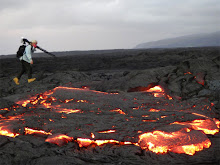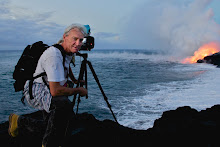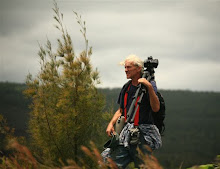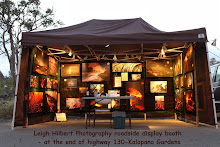
Above: (Nearly) Full moon night rainbow taken last evening around 10:00 PM
We are looking west across Kalapana Gardens. The text on the photo describes more of the scene. You can click on it for a larger view window.
The surface lava tube breakout in the middle, just overtop the houses, was new to the overall scene we have usually had these past weeks. It was a bright and intense breakout and had ignited some forest sending balls of yellow flames into the air. This forest kipuka would be very near to where Jack Thompson's place was located until it was consumed by lava on March 2nd last year.
Meanwhile, up on the Pu`u O`o crater lava has been spewing out the northern flank for some weeks now--- Mostly flat terrain right there but if the lava surged heavy and prolonged in that area it could, in time, pose new threats to communities makai of that elevation.
The USGS/HVO have been documenting this event, and the Halema`uma`u Crater well and you can see photos and descriptions on their 'Photos & Videos' web page, which is where I grabbed this great overview image below of the ocean entry lava with the Pulama Pali on the right.
If you click for the larger size you can see, in the shadows on the bottom right, a helicopter and also white pillars that were once the foundation of a cabin until it was taken by lava about five years ago. Also, for those that remember the big Waikupanaha ocean entry we had from January 2008 until January 2011, it was located in the very bottom right corner of the photo.
 Photos below: Waikupanaha lava viewing area July 2008 (click any photo for a lager size viewer of all images)
Photos below: Waikupanaha lava viewing area July 2008 (click any photo for a lager size viewer of all images) 














